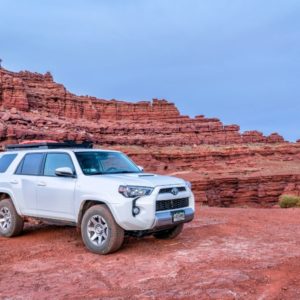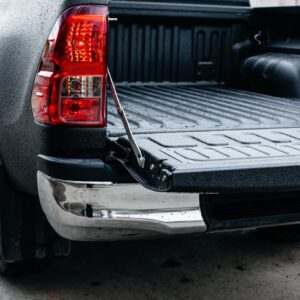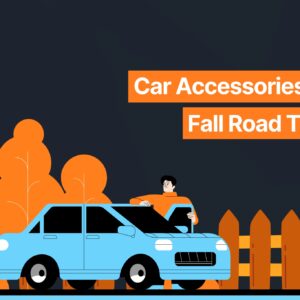Despite how common driving is, there’s no denying it can be dangerous. Every car on the road is a two-ton death machine — a slip at high speed, an abrupt turn, or a faulty brake is all takes to cause serious and even fatal injury.
Though most people drive safely to prevent these situations, there are times when accidents are beyond anyone’s control.
Fortunately, there are many safety features and accessories you can install on your vehicle to minimize the risk of road accidents.

Blind Spot Detection Sensor
The blind spot detection sensor is used to monitor a driver’s blind spots, hence the name. It helps drivers watch out for potential obstacles in areas that would normally be difficult (if not impossible) to see from the driver’s seat.
Blind spot detection sensors use cameras, radars, or sensors around the vehicle to monitor the vehicle’s sides and rear of the vehicle. They alert the driver if they spot an obstacle, such as debris, a pedestrian, or another vehicle.
Depending on the sensor, the alert could be a warning beep, a flashing light, or a rumbling sensation in the steering wheel. Alternatively, you can invest in a blind spot mirror.
Blind Spot Mirror
Blind spot mirrors differ from regular side mirrors in how they provide drivers with an even wider viewing angle. They’re typically installed on the side mirrors themselves and help drivers cover their blind spots.
These mirrors are always installed in pairs and prevent drivers from crashing when they change or merge lanes. They make it easier for drivers to see approaching vehicles, pedestrians, and other obstacles that might collide with them.
Blind spot mirrors are easy to install, use, and obtain. They’re affordable and can be attached with nothing more than clamps or adhesive. You won’t have to screw anything in or fiddle with any wires to get your blind spot mirrors working.
Lane Departure Camera
Another useful safety feature to reduce the risk of road accidents is the lane departure camera, a vital component of a vehicle’s advanced driver assistance system.
The lane departure camera monitors a vehicle’s position within its lane, making it easier for drivers to avoid accidents brought about by lane deviation. Sometimes people accidentally drive out of their respective lanes, exposing themselves to collision accidents by driving into other vehicles — this camera helps reduce that risk.
The lane departure camera can typically be found on the windshield by the rearview mirror. It scans the road ahead, taking note of the lanes by detecting the lines. This camera warns the driver, typically by sound, vibration, or flashing light, whenever the vehicle goes out of the lane.
Some vehicles already have lane departure cameras installed so make sure to check before installing one.
Light Bar
A good accessory you can install on your vehicle to increase your visibility in darkness is a light bar. It consists of numerous LED or halogen lights arranged in one big bar.
Sometimes, headlights are insufficient for night-time drives, and some roads will require stronger lights if you want to navigate them safely. This is where a light bar becomes a smart investment.
Though they’re typically used for off-road driving, light bars make it much easier for other drivers to see you, especially in low-visibility conditions such as rainfall, heavy fog, and snowstorms. They’re commonly mounted on the roof of the vehicle to provide light from an elevated, front-facing position.
TPMS Monitor
The TPMS Monitor, also known as the tire pressure monitoring system monitors the level of air pressure inside the tires. It’s used to prevent tires from getting either underinflated or overinflated by alerting drivers when the air pressure falls outside of standard levels.
There are two types of TPMS: direct TPMS and indirect TPMS.
Direct TPMS uses sensors inside each tire to measure the air pressure, sending the data to the vehicle’s computer and warning drivers when pressure is too low. Indirect TPMS uses wheel speed sensors to detect differences in wheel rotation speeds to determine whether a tire has sufficient air pressure or not.
Tire pressure levels need to fall under specific levels or else the vehicle becomes more vulnerable to road accidents.
Underinflated tires reduce stability and handling while making the vehicle more susceptible to skidding and hydroplaning. Overinflated tires have less traction and grip. Both run the risk of tire blowouts, which not only destroy the tires but also make drivers more likely to lose control and crash.
Horn Kit
Sometimes, the horn that comes pre-installed in a vehicle isn’t loud or noticeable enough to alert pedestrians or other drivers. Fortunately, drivers can use horn kits to replace their car horns to make them more effective.
There are many kinds of horn kits, with the most common type being electric horn kits. These horns are adjustable and offer a variety of custom noises that drivers can change freely. There are also train horn kits that let vehicles make loud alarming noises reminiscent of the horns used by trains.
Any information provided on this Website is for informational purposes only and is not intended to replace consultation with a professional mechanic. The accuracy and timeliness of the information may change from the time of publication.























